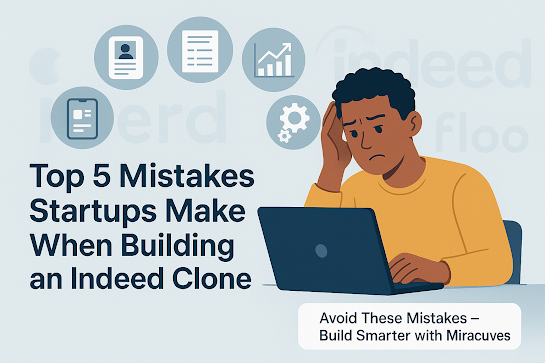Top 5 Mistakes Startups Make When Building an Indeed Clone
In 2025, job seekers aren’t just browsing desktop job portals anymore. They're swiping on their phones, scrolling through remote gigs, and juggling career changes on the fly. If you’re thinking about launching your own job board platform, building an Indeed clone probably sounds like a great plan. I get it—Indeed is the big name, the blueprint. But before you dive headfirst into development, let me give you a heads-up: simply copying Indeed won't cut it.
I've seen too many startups pour their time and money into a clone, only to end up wondering why nobody's signing up or posting jobs. So I put together the five most common (and avoidable) mistakes founders make when building an Indeed-like platform. Trust me, steering clear of these could save you a fortune—and help you build something people actually want to use.
1. Blind Copying Without Any Differentiation
This one’s a classic. I’ve seen founders mimic every button and layout of Indeed, thinking it’ll work like magic. But here’s the problem: users don’t need another Indeed. They need something better or something specific.
Are you targeting freelance designers? Construction workers? Healthcare pros? Each audience has different needs. Your UX, filters, and even job categories should reflect your niche. Don’t just copy. Customize.
2. Ignoring Employer Experience
Startups often focus so hard on job seekers, they forget who really funds the platform: employers. If posting a job or managing applicants feels clunky, they’ll bounce. Worse, they’ll go back to Indeed or LinkedIn.
You need to roll out the red carpet for employers. Make posting easy. Offer dashboards that simplify hiring. Automate where possible—think resume filters, outreach templates, and analytics. It helps them, and it gives you monetization opportunities later.
3. Underestimating the Power of Algorithms
Job seekers hate irrelevant listings. Employers hate random applicants. What solves both? A good matching engine.
No, you don’t need to build Google-level AI. But you do need keyword filters, user behavior tracking, and some basic NLP to connect the right people with the right roles. Without relevance, users drop off fast.
4. No Monetization Strategy from the Start
Some founders treat monetization like an afterthought. Big mistake. If your job board is 100% free and you haven’t tested what users will pay for, you’re walking into a cash trap.
Test monetization from day one. Think ads, featured listings, employer subscriptions, or even premium job seeker tools like resume boosters. You need real feedback on what adds value.
5. Skipping Mobile Optimization
It’s 2025. People are job hunting on the go. If your platform isn’t built for mobile-first, you’re losing users. Plain and simple.
Your Indeed clone should feel like a native app—smooth, responsive, and fast. That means tap-to-apply features, clear CTAs, and lightning-fast load times. Bonus points for push notifications that keep users coming back.
Conclusion: Build Smarter, Not Just Faster
You don’t need to reinvent the wheel to build a successful job board. But you do need to innovate on top of the foundation. Focus on your niche. Prioritize employer experience. Build smart search. Monetize early. And never ignore mobile.
Want to dig deeper into each of these points? Check out the full blog: Top 5 Mistakes Startups Make When Building an Indeed Clone
Avoiding these mistakes won’t guarantee success, but it will set you way ahead of the curve. And if you're ready to take the next step, Miracuves can help you build a job board that actually works.
Ready to build your dream job platform? Let’s chat.



Comments
Post a Comment